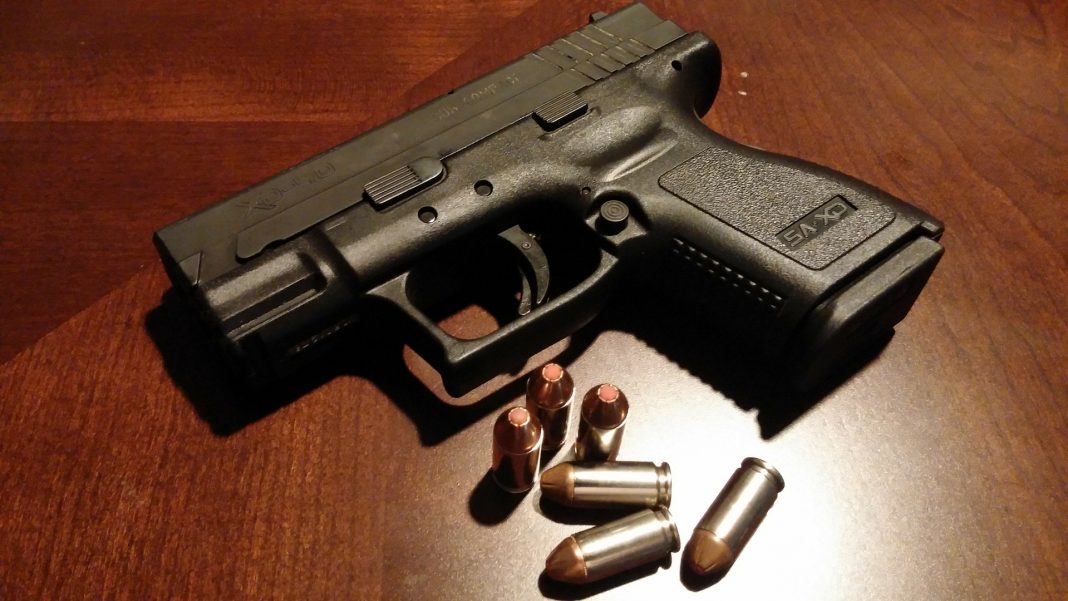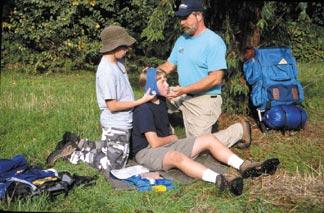 |
|
| Website Exclusive • December, 2003 |
One of our readers e-mailed John Silveira to tell him that taking a handgun afield after a long layoff had resulted in some scary moments. While gun handling is not a perishable skill, it is certainly a corrosion-prone one. The skills don’t really die, but they sure can get rusty fast. The reader suggested that Backwoods Home’s firearms editor write a sort of handling refresher on firearms. John liked the idea, Dave Duffy concurred, and so did the gun editor. That’s all it takes, folks; Backwoods Home is your magazine, and the staff takes your suggestions seriously. Since the reader’s problems were with handguns, we’ll start there with this installment. In Part II, we’ll follow with shotgun handling tips, and in Part III, we’ll cover protocols for handling rifles.
Things to check
|
First, make sure the gun is in proper working order. If there’s any doubt, take it to your local gunsmith for a quick check-over. Review the owner’s manual. If you don’t have one, they are readily available direct from the company that manufactured the firearm in question. If the gun’s manufacturer is no longer in business, J.B. Wood’s Gun Digest series on the disassembly of firearms is a good reference.
Next, make sure you have the right ammunition. The caliber should be stamped on the barrel or slide of your handgun. Ammo designations can get a bit confusing. You can fire .38 Special in a .357 Magnum revolver, but not .357 Magnum ammunition in a .38 Special revolver. Your gun shop may sell all manner of .45 caliber handgun ammunition, but not all of it will fit your semiautomatic pistol in that caliber. .45 Colt revolver ammo will not work in your autoloader, nor will .45 Schofield ammo reintroduced of late for cowboy action shooting. Neither will .45 Auto Rim, designed for revolvers chambered for the auto pistol cartridge (I told you it would be confusing). Nor should you load a standard .45 auto with the short new cartridge called .45 Glock, and your chamber and magazines will both be too short for .45 Winchester Magnum. Your conventional .45 caliber semiautomatic needs ammunition marked “.45 Auto,” “.45 Automatic,” or “.45 ACP” (Automatic Colt Pistol). When in doubt, bring the unloaded gun to a gun shop and ask for advice. This is one of the many advantages of buying your arms and ammunition from a dedicated gun shop instead of the Monster Mart. At the latter, the clerk on the gun counter may have been transferred to that post from the costume jewelry department an hour before you got there, and could prove worse than clueless.
Ammo choices
Once you have the right caliber, there’s one more step to the ammunition selection process. For defense against criminal intruders, you want hollow point ammunition as used by police. It is designed so that the bullet “mushrooms” and slows down, hopefully staying in the body of the offender instead of exiting his back to strike an unseen bystander. Hollow point ammo is also less likely to ricochet.
|
||
|
||
|
Solid nose, or “ball” ammunition, while fine for practice and target shooting, is overpenetrative for the self-defense function. A round of GI .45 hardball will pierce a full 26 inches of muscle tissue-simulating ballistic gelatin. That means if three average-size people are standing in a row, such a bullet can go through and through the chests of the first two and lodge in the heart of the third. Not the sort of thing you want to unleash in your own family’s home, or on a city street.
Where deep penetrating handgun rounds come into their own is for defense against large animals. My old friend Elgin Gates, the late, great big game hunter, once saved his own life with a handgun in Africa. He had climbed a small tree to get away from a huge, enraged Cape Buffalo that was trying to butt down the tree so he could trample Elgin. Elgin killed him with a single round of armor-piercing ammunition from the Smith & Wesson .357 Magnum revolver he prudently carried on his belt as backup to his Weatherby Magnum hunting rifle, which he had been unable to reach in this incident. The single deep-penetrating bullet punched through the massive skull of the creature and killed it instantly.
Another friend in Africa, Phil Honeyborne, also found use for deep penetrating handgun bullets on big game animals. He once killed a marauding elephant with a single 320 grain SSK hunting bullet out of a Ruger Super Blackhawk .44 Magnum. It punched all the way through the pachyderm’s chest, piercing the heart en route, and stopped under the tough hide on the opposite side of the giant beast. However, his big concern in the district where he worked was lion attack. His daily carry gun was an American Colt .45 Government Model automatic, loaded with 230 grain full metal jacket “hardball.” With an 8-round Wilson magazine and a ninth round in the chamber, he had nine of those big pills with which to medicate enraged man-eaters. With the big cat on top of him, more than two feet of penetration through heavy muscle would be a good thing instead of the usual bad thing.
Handling your handgun
Let’s look at handling protocols.
|
Many country folks prefer the old-style single action revolvers as seen in Western movies. These should always be carried with an empty chamber under the hammer. Most specimens in existence, if there is a round under the hammer, can go off unintentionally if bumped or dropped. Yes, there are guns with firing pin blocks and modern transfer bar mechanisms (the latter is found on New Model Ruger single actions) which can be safely carried with a round under the hammer. Still, it’s a lousy habit to get into. One day, you may transfer that habit to a different single action which is not safe when so carried. You may also unwittingly become a role model for a neighbor who then carries his old-fashioned gun the wrong way, with tragedy resulting. Even with the new Rugers, professionals make a point of leaving the chamber under the hammer unloaded.
With any firearm in generaland with the handgun in particular, since because it is so short it is easier to inadvertently point in the wrong directionit is wise to memorize and live by Col. Jeff Cooper’s four rules of gun safety”
- Treat every firearm as if it is fully loaded.
- Never allow the muzzle to point at anything you are not prepared to see destroyed.
- Never allow your finger to touch the trigger or even enter the trigger guard unless and until you are in the very act of intentionally firing.
- Always be safely certain of your target and what is behind it.
|
You don’t want to carry a round in the chamber of any semi-automatic pistol that doesn’t have a firing pin lock. It’s not drop-safe. This includes the majority of .22 caliber semiautomatic pistols out there. Carry them with a full magazine and empty chamber, and activate the slide to chamber a round when it comes time to shoot. If that sounds too slow for self-defense, I agree with you. Do what I did and what every modern police department does for its troops, and equip yourself with a pistol that is drop-safe and therefore safe to carry with a cartridge in the firing chamber.
With the older model 1911 pistols that do not have firing pin safeties, have a pistolsmith install a light Titanium firing pin with a heavy-duty firing pin spring. This combination should prevent an “inertia fire” discharge if the gun is dropped or struck. Springfield Armory has been producing their 1911 style pistols this way for a couple of years now. 1911 pistols with firing pin safeties include the Colt Series ’80, the Para-Ordnance, the Kimber II, series and the new SW1911 from Smith & Wesson.
If your pistol is a single action semiautomatic, and it is drop-safe, the best way to carry it is cocked and locked. That is, the hammer is cocked back and the thumb safety is engaged, with a round in the chamber. This is known also as “Condition One.” The “cocked” part scares police chiefs and a lot of new shooters, but the “locked” part comes into its own if an unauthorized person gets his hands on your gun. Unless he is intimately familiar with that pistol, it will take him a while to figure out where the safety is and how it works before he can make it go off. If you prefer a double action pistol, carried with the hammer at rest, but like the idea of a manual safety, you can have it both ways with a standard model Beretta, Ruger, or Smith & Wesson semiautomatic pistol in a variety of sizes and calibers. If you prefer the Glock pistol, you can have the aftermarket Cominolli manual safety installed for less than $150 at the backwoods home gun shop of master armorer Rick Devoid at Tarnhelm Supply, www.tarnhelm.com, (603)796-2551.
According to outdoorsman customs, the shotgun is normally carried in the hands; the rifle is carried in the hands or on a sling over one shoulder; and the handgun is carried in the holster. Holster and handgun are a system, part of which is the belt on which the holster rides, and all three should be top quality.
Some argue that a defensive handgun should be carried in an open top holster for fastest possible draw, but those folks tend not to live in the backwoods. In rough country, taking a tumble is an everyday fact of life. When you get back up and dust yourself off, you want your gun to still be in the holster. This goes double if the fall has taken place on a hillside, beside a body of water, or in the snow or the mud. Do yourself a favor and get a holster with a safety strap. If it has a thumb-break release there will be little if any sacrifice of drawing speed so long as you practice with it.
In inclement weather, carry the gun under your clothing to protect it. It’s legal on your own property in most jurisdictions whether or not you have a concealed carry permit, so long as the gun itself is legally in your possession. If you want to wear the gun openly during bad weather, invest in a flap holster. Remember, however, that the holster itself will eventually become soaked in weather like that, and you should remove the handgun and clean and lubricate it at the first opportunity.
|
When you draw a handgun from its holster, make sure that your finger does not enter the trigger guard until you are on target and have decided to fire right now. When holstering, keep the trigger finger extended straight. This not only helps point the gun into the holster, but guarantees that the finger will not catch between trigger and holster. If that happens, finger and trigger will stop, but the gun will keep going; in an instant, the trigger is pulled and a shot is fired in the holster.
I’ve long preached that a shooter should holster a gun with the thumb on the hammer. If it is a double action gun, this prevents the hammer from rising and falling and thus releasing a shot if something catches the trigger. If it is a cocked and locked single action semiautomatic, the thumb can catch the hammer if it starts to fall after the trigger has accidentally been interdicted.
This holstering procedurethumb on hammer, trigger finger extendedwould probably have prevented the overwhelming majority of accidental discharges that have taken place during the holstering process.
Whenever a drawn gun is out, whether you’re holding it in one hand or two, keep it out in front of you and in a safe direction where you can see it. The typical “low ready” position is with the muzzle down, 45 degrees to the target. This keeps you from inadvertently pointing at someone who suddenly happens to emerge in front of you, and if a shot is fired it will go safely into the ground.
|
You don’t want to let the gun get down below line of sight. If you do, it will wind up pointing at your own lower extremities or those of others. There will also be the possibility that the gun will now snag on unseen brush or other obstacles, which could trigger an accidental discharge. If you’re searching for something that went bump in the night, anyone behind you can grab a gun out of your hand held down to your side before you can react. But, if the gun is out in front of you, their arm will have to pass into your field of vision before grabbing your gun, buying you time to perform a retention technique and counter the disarming attempt. As a general rule: If you can’t see your own drawn gun, you are not in control of the weapon.
If you’re a left-handed shooter, make sure your semiautomatic pistol has controls where a southpaw can naturally and comfortably reach them. Shooting with a handgun incompatible with your hand is a loser’s game.
Remember that it’s your responsibility to keep lethal weapons where children, intruders, drunk or otherwise “judgment challenged” adults, etc., cannot gain control of them. There are any number of quick-access gun vaults on the market.
Personally, I’ve found that the best way to have a firearm readily accessible to you but inaccessible to unauthorized personnel is to have a compact, powerful handgun in a comfortable holster and always carry it on your person. This got me through the raising of two inquisitive and adventurous children, and a period of time in which I took in an elderly relative who was suffering from Alzheimer’s Disease and occasionally violent. Today, divorced and with the kids “grown, flown and on their own,” I live alone and still maintain the habit. It’s not inconvenient once you get used to it, and the need for a loaded firearm does tend to come upon you suddenly and by surprise, especially for those of you who live in the backwoods…
|
Semiautomatic pistols are more complicated to operate than double action revolvers, and it is easier to make mistakes with them. The popular recreational firearms press doesn’t always help, occasionally illustrating handling protocols that can get the average person in trouble.
When checking the chamber of a semi-automatic pistol, never do the trendy “pinch check” in which the thumb of the support hand hooks into the trigger guard and the index finger reaches under the muzzle to press back the slide. Putting your finger in such close proximity to the muzzle of a possibly-loaded gun is nothing short of dangerously stupid. One master shooter blew his index finger off at a pistol match doing exactly that with a light-triggered 1911 .45 automatic.
It came into fashion subsequently to grasp the front of the slide to press it back. This too is dangerous. Famed firearms instructor John Farnam recently reported the case of an unfortunate man who managed to blow not one but two fingers off while doing that. The gun industry aids and abets this practice by putting grasping grooves on the front as well as the rear of the slide on many models.
Take John Farnam’s advice, and mine. Always retract the slide of a semiautomatic pistol by using the grasping grooves located at the rear of the slide.
When operating an auto pistol’s slide, consider using the Israeli method instead of the American method. The American method, or “overhand,” has the palm of the support hand down on top of the slide with the thumb toward you. It feels good and strong, but unless done very carefully, it tends to pull the gun’s muzzle toward the weak hand side. Soon the pistol is pointing at your own forearm, or perhaps at the person next to you.
|
The Israeli method has also been called “the slingshot technique” because it mimics the movements you would use to operate a slingshot. The gun arm stays locked, pointing the handgun at the target or backstop, while the free hand grasps the slide with the thumb forward. Pushing forward with the gun hand while pulling back with the support handdigging in your rear heel on the strong hand side and driving your body weight forward, as if delivering a hard punchmakes this technique actually stronger than the American style. My little girls were able to work full size Colt .45 automatics with this technique when they were eight-years-old. Perhaps more important, the body mechanics of the Israeli technique keep the muzzle downrange in a safe direction during the entire operation.
Always use ear and eye protection when shooting, and make sure everyone around you does the same. If you have not had a firearms safety course, your local gun shop or police department can probably steer you toward one in your area. Failing that, your state’s department of fish and wildlife keeps lists of qualified Hunter Safety and Firearms Safety instructors and should have someone in your area. Another source of leads on instructors is the National Rifle Association, whose toll-free number is 1-877-NRA-2000.
Consider joining a gun club. It’s a great source of knowledge and experience, and gun clubs for the most part tend to be “jerk-free environments” that people with backwoods home values are likely to enjoy.
Next time, in Part II, we’ll look at handling tips for shotguns.

























In 2015 I put Cominolli safeties in two of my Glock 29’s and they worked great. For a year. Then they started kicking up their levers after most every shot and going into ‘safe’ mode. Not safe if you need a string against bad guys who are trying to kill you. Maybe this happens only in the 40F temps where I found it happen, or maybe it happens only with 10mm. Not wanting to diddle, I switched all my Glock 29’s and 20’s to Siderlock safeties, and have had zero defects since, to current May 2020.